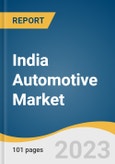The India automotive market demand is expected to reach 8,363,344 units by 2030, according to the report. It is anticipated to register a CAGR of 9.7% from 2023 to 2030. The automotive demand is driven by the rapid adoption of technology and the strong policy support from the government. Additionally, increasing awareness about environmental concerns resulting in the adoption of alternate fuel vehicles (CNG, EVs), which, in turn, is driving the market growth.
Technological advancements in the entire supply chain are anticipated to drive the market in the next seven years. For instance, companies are adopting alternate channels such as e-commerce websites to sell vehicles. Selling commercial vehicles through e-commerce websites helps the OEMs in widening their distribution network and reducing the infrastructure and labor costs. For example, Eicher Motors Limited has recently launched five new vehicles that are exclusively available through the e-commerce channel. Similarly, sales of Tata Motor’s small commercial vehicles and pickups have increased by 25% after the company opted for the e-commerce channel to sell its vehicles.
Amid the pandemic, the need to adhere to social distancing norms has encouraged consumers to invest in personal mobility options. This demand for personal transport options is a silver lining for automakers and is expected to marginally favor the growth of the country’s automotive industry over the forecast period. Isolated transport options are emerging as the need of the hour, with several consumers opting for entry-level cars amid economic uncertainties. Shared mobility is expected to take a hit in the light of this ongoing trend. As the trend is significantly impacted by the consumer’s spending power, it is expected that consumers with high spending capacity will dominate the sales of personal transportation options.
Technological advancements in the entire supply chain are anticipated to drive the market in the next seven years. For instance, companies are adopting alternate channels such as e-commerce websites to sell vehicles. Selling commercial vehicles through e-commerce websites helps the OEMs in widening their distribution network and reducing the infrastructure and labor costs. For example, Eicher Motors Limited has recently launched five new vehicles that are exclusively available through the e-commerce channel. Similarly, sales of Tata Motor’s small commercial vehicles and pickups have increased by 25% after the company opted for the e-commerce channel to sell its vehicles.
Amid the pandemic, the need to adhere to social distancing norms has encouraged consumers to invest in personal mobility options. This demand for personal transport options is a silver lining for automakers and is expected to marginally favor the growth of the country’s automotive industry over the forecast period. Isolated transport options are emerging as the need of the hour, with several consumers opting for entry-level cars amid economic uncertainties. Shared mobility is expected to take a hit in the light of this ongoing trend. As the trend is significantly impacted by the consumer’s spending power, it is expected that consumers with high spending capacity will dominate the sales of personal transportation options.
India Automotive Market Report Highlights
- The hatchback segment held the largest market share of 40.2% in 2022. The large market share is attributed to its smaller size, suited to Indian roads. The country's prominent passenger car manufacturers have also developed small hatchbacks suited to the Indian market.
- The Light Commercial Vehicles (LCVs), ranging between 2 to 3.5 tons segment, accounted for the largest volume of 47.7% in 2022
- The buses with tonnage capacity ranging between 3.5 to 7.5 tons segment held the largest volume share of 51.1% in 2022. The segment primarily includes intra-city buses and special-purpose buses used for school, local tours, ambulance, hospitality, and other services.
- The more than 25 tons segment held the largest volume share of 53.4% in 2022. Growing demand for goods and increased construction and infrastructure development drive the heavy trucks market demand.
- The less than 2 tons segment is estimated to register the fastest CAGR of 12.9% over the forecast period. The primary factor influencing the growth rate is the use of light vehicles for last-mile deliveries.
Table of Contents
Chapter 1. Methodology and Scope
Chapter 2. Executive Summary
Chapter 3. India Automotive Market Variables, Trends & Scope
Chapter 4. India Automotive Market: Passenger Vehicles Estimates & Trend Analysis
Chapter 5. India Automotive Market: Light Commercial Vehicles Estimates & Trend Analysis
Chapter 6. India Automotive Market: Heavy Trucks Estimates & Trend Analysis
Chapter 7. India Automotive Market: Buses & Coaches Estimates & Trend Analysis
Chapter 8. Competitive Landscape
List of Tables
List of Figures
Companies Profiled
- ASHOK LEYLAND
- Bajaj Auto Ltd.
- Mercedes-Benz Group AG.
- EICHER MOTORS LIMITED
- Honda Motor Co., Ltd.
- Hyundai Motor India
- Mahindra&Mahindra Ltd.
- MARUTI SUZUKI INDIA LIMITED
- Piaggio & C. SpA
- Tata Motors
- TOYOTA MOTOR CORPORATION.
- Volkswagen Group
- AB Volvo
Methodology

LOADING...
Table Information
| Report Attribute | Details |
|---|---|
| No. of Pages | 101 |
| Published | November 2023 |
| Forecast Period | 2022 - 2030 |
| Estimated Market Value in 2022 | 3.64 Million Units |
| Forecasted Market Value by 2030 | 8.36 Million Units |
| Compound Annual Growth Rate | 9.7% |
| Regions Covered | India |
| No. of Companies Mentioned | 13 |









